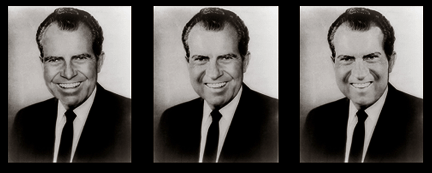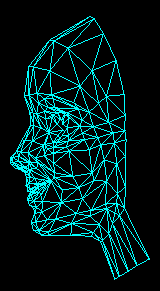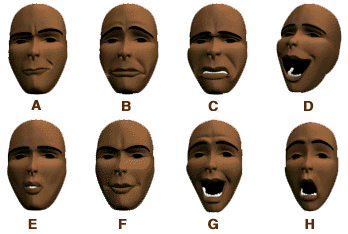

bicameral (bi-kam-ê-ral) adj. having two legislative chambers.
Okay, I didn't make up the term.
The term was coined by psychologist Julian Jaynes, who presented the idea in his 1976 book The Origin of Consciousness in the Breakdown of the Bicameral Mind. But it fits so well in describing an extremely interesting phenomenon that many people may not realize -- each of us is really two people. No, I don't mean in the traditional sense of having an alter-ego, or a good and bad side. Nor do I mean that we are all schizoids. I mean we are literally two thinking beings residing in the same body.
Early hominids had one mind. It was what psychologists call a "reactive" mind. It only exhibited what we would consider higher thought processes when it was presented with a problem. It didn't plan for the future or imagine how to improve things like a dwelling, a tool or escaping a predator. It only reacted to situations that happened in the "here and now." But, according to Jaynes, a sudden improvement happened when the human brain decided to double its efforts in thought processing. Now, although you and I have one brain, each half of it has the ability to act independently at the same time.
Like the infomercials say -- "Wait! There's more!"
Follow along on this adventure. I won't disappoint either of you!
About ten years ago, I saw an interesting exercise in which a college psychology professor had taken photographs of her students, made copies that were flipped left to right, and then had them cut in half vertically. She reassembled the images using the two similar sides of the face.

Which Nixon would You buy a used car from?
Nixon's left+left at the far left.
The center image is the normal, original portrait.
Nixon's right+right is on the right.
[A quick way to do this is to place a small mirror perpendicular to a photograph showing a good front face view. As you look into the mirror you can form a whole face from the reflection of either side.]
The composite pictures were humorous. Although the individuals were easily recognizable, their facial expressions seemed to express exaggerated emotions, like anger, suspicion, or happiness -- and occasionally a look of total blankness. Even more interesting was the observation that the two sides of the same face were often so different. Why?
This exercise seemed to suggest that, while a handful of people have symmetrical faces, a vast majority of us do not. Also it raised the possibility that each side of our face could express different emotions at the same time! Subsequent research into facial expressions and the workings of the human brain has offered an interesting theory that not only explains this left and right difference in facial expressions, but could help us to understand our "other self."
First, some science.
We'll keep this light and uncomplicated. Our brain, like the rest of our anatomy, is made up of two halves, a left brain a right brain. There's a big fold that goes from front to back in our brain, essentially dividing it into two distinct and separate parts. Well, almost separate. They are connected to each other by a thick cable of nerves at the base of each brain. This sole link between the two giant processors is called the corpus collosum. Think of it as an Ethernet cable or network connection between two incredibly fast and immensely powerful computer processors, each running different programs from the same input.
 The left side of our body is "wired" to the right side of our brain, and vice versa. For whatever reason nature did this cross-over, it applies even to our eyes, which process a majority of their sensory data on opposite sides of the brain.
The left side of our body is "wired" to the right side of our brain, and vice versa. For whatever reason nature did this cross-over, it applies even to our eyes, which process a majority of their sensory data on opposite sides of the brain.
We can thank Nobel Prize Winner (1981) Roger Sperry for this next contribution. Sperry conducted what are sometimes called the "split-brain" experiments. Here's how it went: A patient suffering from uncontrolled seizures had an area of his brain removed by surgery in an attempt to control his illness. This area just happened to be the corpus collosum, which was suspected of having developed lesions (short circuits).
Following his surgery, Sperry's patient seemed completely normal -- almost. A series of tests were conducted where each "half" of the patient was isolated from the other. Different visual and tactile information could then be presented to the patient's left or right side, without the other side knowing. The results were astounding.
With their communications link severed, each side of the patient's brain was functioning independently. Although this did not prevent his ability to walk, talk and eat, some unexpected findings were encountered in some of the higher brain functions when each side was examined independently of the other.
The right hand and eye could name an object, such as a pencil, but the patient could not explain what it was used for. When shown to the left hand and eye, the patient could explain and demonstrate its use, but could not name it. Further studies showed that various functions of thought are physically separated and localized to a specific area on either the left or right side of the human brain. This functional map is consistent for an estimated 70 to 95 percent of us.
The main theme to emerge... is that there appear to be two modes of thinking, verbal and nonverbal, represented rather separately in left and right hemispheres respectively and that our education system, as well as science in general, tends to neglect the nonverbal form of intellect. What it comes down to is that modern society discriminates against the right hemisphere.
-Roger Sperry (1973)
Upon completing the map, it was becoming clear to researchers that each side of the brain had a characteristic way that it both interpreted the world and reacted to it. The chart below will help illustrate the characteristics which are known to reside on each side of our brains.
|
LEFT BRAIN |
RIGHT BRAIN |
Our personality can be thought of as a result of the degree to which these left and right brains interact, or, in some cases, do not interact. It is a simplification to identify "left brain" types who are very analytical and orderly. We likewise certainly know of the artistic, unpredictability and creativity of "right brain" types. But each of us draws upon specific sides of our brain for a variety of daily functions, depending on such things as our age, education and life experiences. The choices of which brain is in control of which situations is what forges our personalities and determines our character.
Experiments show that most children rank highly creative (right brain) before entering school. Because our educational systems place a higher value on left brain skills such as mathematics, logic and language than it does on drawing or using our imagination, only ten percent of these same children will rank highly creative by age 7. By the time we are adults, high creativity remains in only 2 percent of the population.
The Brain and Intelligence
There is a known correlation between brain size and intellectual ability. Homo Erectus, our distant ancestor, had a brain size of about 1200 cc. Modern Homo Sapiens have an average brain of about 1400 cc. Oddly, the Neanderthal people who failed to evolve into humans already had a brain size of 1500 cc -- larger than modern man. Obviously then, its not only how big the brain is as much as how it is configured. This is further evidenced by the fact that we have known genius brains measuring as small as 1000 cc. and as large as 2000 cc.
Increasing brain size was a risky endeavor for human evolution. The brain requires a highly stable temperature and a supply of high protein and energy. One quarter of our caloric intake is used for brain energy consumption.
The War of the Brains
The two brains not only see the world in vastly different ways but, in our current society, the left side just "doesn't get" what the right side is all about. It tends to dismiss anything significant coming into consciousness from its "flaky" cranial twin. Sometimes two sides can actually disagree, resulting in our perception of emotional turmoil from the expressive protests of right brain.
Our conscious mind can only focus on data from one brain at a time. We can switch from one side to the other very quickly (with our corpus collosum intact) but that's not always the most efficient way to act and eventually ultimate authority to enter consciousness is delegated to one brain or the other. In our modern world, this battle is almost always won by the left brain.
It appears that most people will never reach their maximum potential because of compromises that have been made between these two governing bodies. Sometimes skills which the right brain can perform better are routinely handled, with less skill, by the left brain. Ideally, both brains work together in people with optimum mental ability. This coordinating ability may be the key to superior intellectual abilities. In most people, however, the left brain takes control, choosing logic, reasoning and details over imagination, holistic thinking and artistic talent.
Methods have been devised to "shut off" the left brain, allowing the right side to have its say. Creative writing courses often use this method to combat "writer's block." The logical left side is easily bored by lack of input and tends to "doze off" during such activities as meditation (repeating a mantra or word over and over) or in sensory deprivation environments. The right brain is then able to "sneak" into our consciousness, filling our minds with emotional and visual vignettes and freely associated images. All too quickly, though, the left brain will assert itself and dispense with these irrational images, asserting its Spock-like logical dominance and the right brain will have to be content to find expression in dreams.
Bicameral Images
Facial expressions are nothing more than skin and muscle being pulled or flexed according to the control of the brain. Our facial nerves effectively divide our face into two separate sides, each controlled by the opposite side brain. Facial expressions are the earliest form of communication. Experiments conducted on all ages and cultures around the globe have revealed that there is universal agreement to some basic emotional facial gestures. Take a moment to see how well you can determine the emotional content of these selected expressions.

Look at the facial expressions depicted above.
Write the corresponding letter that represents your interpretation of each of the following emotions:
HAPPY, DISGUST, CONCERNED, SURPRISED,
SUSPICIOUS, SAD, HORRIFIED, ANGRY.
When you've made your list, check here for most popular interpretations.
Now that (hopefully) you are confident about your innate ability to "read" emotions, let's turn our attention to the bicameral images. Let's use this understanding of left and right brain traits to examine some known personalities. While looking at this gallery of faces, ask yourself which side appears to dominate? -- which emotions seem to be expressed by each side? -- what's your gut reaction to each facial expression? In some cases, two opposite personalities will be evident while in others (Princess Diana, for example) there seems to be a more uniform and symmetric look.
If you'd like to submit a photo of a public figure or politician for us to show, please send scans on either jpeg or gif formats to myristicin@hotmail.com.
As you view these pictures, remember that the images on your far left represent the left brain, which, as described earlier, is usually the dominant side.

